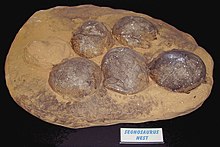Dinosaurland Fossil Museum
| Dinosaurland Fossil Museum | |
|---|---|
| Location | Lyme Regis, Dorset |
| Coordinates | 50°43′33″N 2°56′02″W / 50.72583°N 2.93389°W |
| Built | 1750-1755 |
| Architect | John Whitty |
Listed Building – Grade I | |
| Official name | Congregational Church |
| Designated | 31 January 1974[1] |
| Reference no. | 404523 |



Dinosaurland Fossil Museum (aka Dinosaurland) is a privately owned fossil museum in Lyme Regis, on the Jurassic Coast in Dorset, England.[2][3][4] The museum is located in a historic Grade I listed former congregational church building.
Museum
The museum, opened in 1989, is owned and run by Steve Davies, a former chief palaeontologist for BP.[5][6] It contains a collection of local marine fossils from the Jurassic period. The museum organizes guided fossil hunting walks.[7] There is a museum shop that sells fossils and minerals.[4][8]
The fossil collection is housed on the ground floor.[9] As well as local Jurassic fossils, there are dinosaurs from China. There are also modern shells and skeletons on display. The museum has a small collection of dinosaur fossils on show (such as a large dinosaur coprolite, a Megalosaurus skeleton and a Chinese dinosaur, of unknown genus).
Congregational Church
The museum is located on Coombe Street in a 250-year-old Grade I listed building that used to be a congregational church.[1] The church was built between 1750 and 1755 by John Whitty. It was where Mary Anning (1799–1847), an early fossil hunter, was baptised and later attended for worship.[10]
The two storey building has a hipped roof and rusticated quoins. The round-headed doorway has Doric pilasters on either side. There is a 19th-century addition to the left hand end of the building.[11]
See also
- Lyme Regis Museum
- Charmouth Heritage Coast Centre
- The Dinosaur Museum in Dorchester, Dorset
- Jurassica, Isle of Portland
- Portland Museum
References
- ^ a b "Congregational Church, Coombe Street, Lyme Regis, West Dorset, Dorset". Images of England. English Heritage.
- ^ David Else and Fionn Davenport, Great Britain, Lonely Planet, 2009. Page 309. ISBN 978-1-74104-491-1.
- ^ Oliver Berry and Belinda Dixon, Devon, Cornwall & Southwest England, Lonely Planet, 2008. Page 161. ISBN 978-1-74104-873-5.
- ^ a b Thomas A. Hose, Geotourism: Appreciating the deep time of landscapes. In Marina Novelli (editor), Niche tourism: contemporary issues, trends and cases, Butterworth-Heinemann, 2005. ISBN 978-0-7506-6133-1.
- ^ Fine example of a crinoid!, Midweek Herald, 14 November 2007.
- ^ "Briefing: Dinosaur upgrade in Lyme". Geology Today. 14 (5): 167–168. 1998. doi:10.1046/j.1365-2451.1998.014005162.x.
- ^ Dinosaurland — Lyme Regis Archived 2012-07-13 at archive.today, VisitBritain, UK.
- ^ Dinosaurland Fossil Shop, Lyme Regis, Dorset, UK.
- ^ Dinosaurland Fossil Museum in Dorset, Visitor World, UK.
- ^ Lyme Regis, Panoromic Earth.
- ^ "Forecourt Wall at Congregational Church, Lyme Regis". British Listed Buildings.

